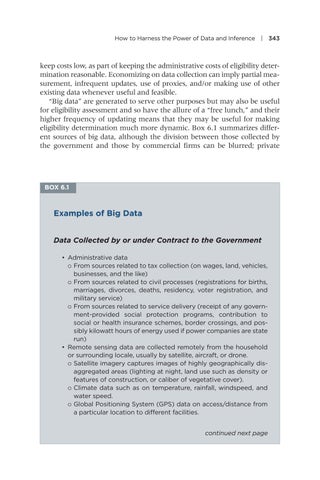How to Harness the Power of Data and Inference | 343
keep costs low, as part of keeping the administrative costs of eligibility determination reasonable. Economizing on data collection can imply partial measurement, infrequent updates, use of proxies, and/or making use of other existing data whenever useful and feasible. “Big data” are generated to serve other purposes but may also be useful for eligibility assessment and so have the allure of a “free lunch,” and their higher frequency of updating means that they may be useful for making eligibility determination much more dynamic. Box 6.1 summarizes different sources of big data, although the division between those collected by the government and those by commercial firms can be blurred; private
BOX 6.1
Examples of Big Data Data Collected by or under Contract to the Government • Administrative data °° From sources related to tax collection (on wages, land, vehicles, businesses, and the like) °° From sources related to civil processes (registrations for births, marriages, divorces, deaths, residency, voter registration, and military service) °° From sources related to service delivery (receipt of any government-provided social protection programs, contribution to social or health insurance schemes, border crossings, and possibly kilowatt hours of energy used if power companies are state run) • Remote sensing data are collected remotely from the household or surrounding locale, usually by satellite, aircraft, or drone. °° Satellite imagery captures images of highly geographically disaggregated areas (lighting at night, land use such as density or features of construction, or caliber of vegetative cover). °° Climate data such as on temperature, rainfall, windspeed, and water speed. °° Global Positioning System (GPS) data on access/distance from a particular location to different facilities. continued next page


